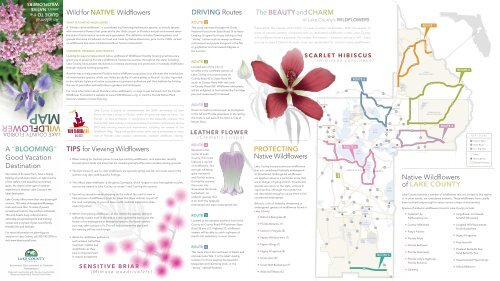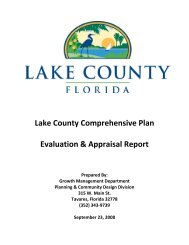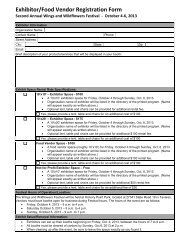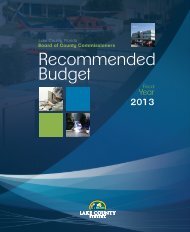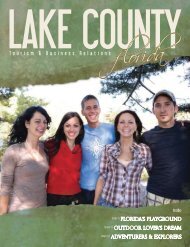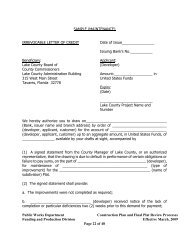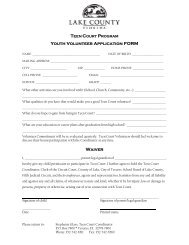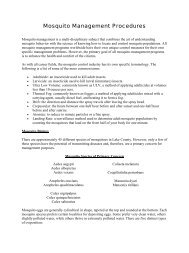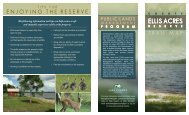Wildflowers Routes Map - Lake County
Wildflowers Routes Map - Lake County
Wildflowers Routes Map - Lake County
Create successful ePaper yourself
Turn your PDF publications into a flip-book with our unique Google optimized e-Paper software.
M A R I O N C O U N T Y<br />
ALCO RD<br />
An informal<br />
Guide to the<br />
area’s NATIVE<br />
wildflowers<br />
Wild for Native <strong>Wildflowers</strong><br />
What is a native wildflower<br />
A “Florida native wildflower” is considered any flowering herbaceous species, or woody species<br />
with ornamental flowers that grew wild in the 1560s as part of Florida’s natural environment when<br />
the state’s first botanical records were generated. This definition includes flowering plants and<br />
grasses that were introduced via travel and trade by Native Americans, prior to the 1560s, as well<br />
as wildflowers that were introduced without human involvement.<br />
Conserve, Preserve and Protect<br />
Looking for ways to help protect native wildflowers? Wildflower-friendly mowing practices are a<br />
great way to preserve Florida’s wildflowers. Numerous counties throughout the state, including<br />
<strong>Lake</strong> <strong>County</strong>, have passed resolutions to increase awareness and protection of roadside wildflowers<br />
through reduced mowing programs.<br />
Another way to help preserve Florida’s native wildflower population is to eliminate the introduction<br />
of invasive plant species, which can inhibit the ability of native plants to flourish. It’s also important<br />
to the delicate balance of native ecosystems to preserve pollinators and their habitats by limiting<br />
the use of pesticides and herbicides in gardens and landscapes.<br />
For more information about Florida’s native wildflowers, or ways to get involved, visit the Florida<br />
Wildflower Foundation’s website at www.Fla<strong>Wildflowers</strong>.org, or visit the Florida Native Plant<br />
Society’s website at www.fnps.org.<br />
Driving <strong>Routes</strong><br />
Route<br />
This route traverses through the Ocala<br />
National Forest from State Road 19 to Astor<br />
Landing. It’s great for those looking to find<br />
“showy” natives such as swamp sunflower,<br />
cottonweed and purple lovegrass in the fall,<br />
or gayfeather and narrowleaf silkgrass in<br />
the summer.<br />
Route<br />
Located east of the City of<br />
Umatilla in the northeast portion of<br />
<strong>Lake</strong> <strong>County</strong>, this route travels on<br />
<strong>County</strong> Road 42 to State Road 44,<br />
south to <strong>County</strong> Road 44A and north<br />
on <strong>County</strong> Road 439. Wildflower enthusiasts<br />
will be delighted to find natives like Partridge<br />
pea and Leavenworth’s tickseed.<br />
The beauty and charm<br />
of <strong>Lake</strong> <strong>County</strong>’s wildflowers.<br />
Experience the beauty and charm of <strong>Lake</strong> <strong>County</strong>’s wildflowers. With thousands of<br />
acres of natural scenery, combined with six dedicated wildflower routes, <strong>Lake</strong> <strong>County</strong><br />
is a wildflower-lover’s paradise. No matter the season – summer, spring or fall – <strong>Lake</strong><br />
<strong>County</strong> is one of Central Florida’s must-see destination for colorful native wildflowers.<br />
Scarlet Hibiscus<br />
(Hibiscus coccineus)<br />
MARION COUNTY<br />
42<br />
ROUTE 6<br />
42<br />
V O L U S I A<br />
19<br />
<strong>Lake</strong><br />
Dorr<br />
C O U N T<br />
Y<br />
445A<br />
445<br />
40<br />
ROUTE 1<br />
Ocala<br />
National Forest<br />
42<br />
ROUTE 2<br />
Route<br />
LADY LAKE<br />
450<br />
450<br />
<strong>Lake</strong><br />
Norris<br />
44<br />
<strong>Lake</strong> <strong>County</strong>, Florida<br />
wildflower<br />
map<br />
A “Blooming”<br />
Good Vacation<br />
Destination<br />
See nature in its rarest form, have a hearty<br />
helping of small-town charm, or take in some<br />
of the state’s most beautiful eco-tourism<br />
spots. No matter what type of vacation<br />
experience is desired, <strong>Lake</strong> <strong>County</strong> is the<br />
ideal destination.<br />
<strong>Lake</strong> <strong>County</strong> offers more than two dozen golf<br />
courses, 130 miles of designated Blueways<br />
trails and more than 14 miles of paved<br />
recreational trails for the outdoor enthusiast.<br />
The area boasts lively cultural events,<br />
nationally-recognized sports and training<br />
venues and a myriad of year-round familyfriendly<br />
fairs and festivals.<br />
For more information on planning your<br />
vacation to <strong>Lake</strong> <strong>County</strong>, call 352-742-3918 or<br />
visit www.lakecountyfl.com.<br />
Economic Development & Tourism<br />
Department<br />
Produced in partnership with the <strong>Lake</strong> <strong>County</strong> Public<br />
Resources Department, Parks & Trails Division.<br />
• lWhen looking for the best places to see eye-catching wildflowers, rural expanses, recently<br />
burned natural lands and areas that are mowed sparingly often serve as ideal viewing-grounds.<br />
• lThe best times of year to view wildflowers are typically spring and fall, but moist areas in the<br />
summer may also yield beautiful findings.<br />
• lThe official state wildflower is the genus Coreopsis, which ranges in color from golden to pink,<br />
and can be viewed in <strong>Lake</strong> <strong>County</strong> on routes 1 and 2 during the summer.<br />
• lUse extra precaution when stopping on the side of the road to view or<br />
take pictures of wildflowers. Look for areas that allow vehicles to pull off<br />
the road completely so you can have a safe roadside experience while<br />
exploring nature.<br />
• lRefrain from picking wildflowers, as this inhibits the species’ ability to<br />
sufficiently sustain itself in the wild. It is also against the law to pick the<br />
flowers of an endangered or threatened species. If a flower catches<br />
your eye, take a picture of it. This will help preserve the plant and<br />
the memory will last much longer.<br />
• lWatch for wildflower pollinators,<br />
such as bees, butterflies,<br />
mammals, reptiles and<br />
amphibians, as they<br />
play an important part<br />
in natural ecosystems.<br />
<strong>Lake</strong> <strong>County</strong> is proud to commemorate the 500th anniversary of Juan<br />
Ponce de León’s arrival in Florida, where he gave the state its name, “La<br />
Florida”, or land of flowers. In recognition of the statewide initiative, Viva<br />
Florida 500, <strong>Lake</strong> <strong>County</strong> is commemorating this historic anniversary during<br />
2013 with exciting events and experiences, including the release of this<br />
Wildflower <strong>Map</strong>. These self-guided routes allow nature enthusiasts to enjoy<br />
one of Florida’s best outdoor adventures, roadside wildflower viewing.<br />
TIPS for Viewing <strong>Wildflowers</strong><br />
Sensitive briar<br />
(Mimosa quadrivalvis)<br />
Known to feature natives such as pricklypear<br />
in the fall and Florida greeneyes in the spring,<br />
this route is just east of the historic City of<br />
Mount Dora.<br />
Leather flower<br />
Route<br />
Situated in the<br />
center of <strong>Lake</strong><br />
<strong>County</strong>, this route<br />
features a myriad<br />
of wildflowers, like<br />
starrush whitetop,<br />
giant ironweed<br />
and Florida betony.<br />
During the summer,<br />
this route also<br />
showcases the Scrub<br />
buckwheat, an<br />
endemic species that<br />
is on both the federally<br />
threatened and state endangered lists.<br />
Route<br />
Located at the extreme southern end of the<br />
<strong>County</strong> on <strong>County</strong> Road 474 between State<br />
Road 33 and U.S. Highway 27, wildflowerviewers<br />
will be able to catch a glimpse of<br />
lizard’s tail, elderberry or even tievine.<br />
Route<br />
(Clematis crispa)<br />
This route sits to the northwest of Eustis and<br />
encloses <strong>Lake</strong> Yale. It is the ideal viewing<br />
location for those seeking the beautiful<br />
bluejacket and heartwing dock, or the<br />
“showy” oakleaf fleabane.<br />
Protecting<br />
Native <strong>Wildflowers</strong><br />
<strong>Lake</strong> <strong>County</strong> boasts numerous wildflowers<br />
that are considered federally endangered<br />
or threatened. Endangered wildflowers<br />
are species native to a particular state that<br />
are in danger of going extinct. Threatened<br />
species are native to the state, and are in<br />
rapid decline; although the number has<br />
not decreased enough to cause them to be<br />
considered endangered.<br />
Below is a list of federally threatened or<br />
endangered species of wildflowers found in<br />
<strong>Lake</strong> <strong>County</strong>.<br />
• lBritton’s Beargrass (E)<br />
• lFlorida Bonamia (T)<br />
• lLewton’s Polygala (E)<br />
• lPapery Whitlow-wort (T)<br />
• lPigeon Wings (T)<br />
• lPygmy Fringetree (E)<br />
• lScrub plum (E)<br />
• lScrub Wild Buckwheat (T)<br />
• lWide-leaf Warea (E)<br />
SUMTER COUNTY<br />
466<br />
FRUITLAND PARK<br />
466A<br />
48<br />
50<br />
441<br />
468<br />
565<br />
470<br />
565<br />
27<br />
44C<br />
44<br />
44A<br />
33<br />
466A<br />
27<br />
466B<br />
MASCOTTE<br />
LEESBURG<br />
27<br />
565<br />
<strong>Lake</strong><br />
Griffin<br />
<strong>Lake</strong><br />
Lucy<br />
GROVELAND<br />
Green Swamp<br />
ROUTE 4<br />
33<br />
Pine<br />
Island<br />
<strong>Lake</strong><br />
POLK COUNTY<br />
Emeralda<br />
Marsh<br />
<strong>Lake</strong><br />
Harris<br />
HOWEY-IN-THE-HILLS<br />
27<br />
48<br />
19<br />
33<br />
565A<br />
478<br />
565A<br />
441<br />
565B<br />
561<br />
561A<br />
452<br />
473<br />
44<br />
Little<br />
<strong>Lake</strong><br />
Harris<br />
<strong>Lake</strong><br />
Minneola<br />
<strong>Lake</strong><br />
561<br />
Minnehaha<br />
<strong>Lake</strong><br />
Nellie<br />
19<br />
455<br />
27<br />
<strong>Lake</strong><br />
Yale<br />
MINNEOLA<br />
CLERMONT<br />
474<br />
561<br />
<strong>Lake</strong><br />
Eustis<br />
<strong>Lake</strong> Louisa<br />
TAVARES<br />
561<br />
27<br />
ASTATULA<br />
455<br />
561A<br />
50<br />
441<br />
44<br />
EUSTIS<br />
19<br />
<strong>Lake</strong> Dora<br />
48<br />
<strong>Lake</strong><br />
Apopka<br />
ROUTE 5<br />
27<br />
19<br />
44<br />
19A 44C<br />
<strong>Lake</strong><br />
Beauclair<br />
MONTVERDE<br />
455<br />
441<br />
UMATILLA<br />
44A<br />
MOUNT DORA<br />
ORANGE COUNTY<br />
ORANGE COUNTY<br />
44B<br />
450A<br />
441<br />
44A<br />
439<br />
44<br />
46<br />
437<br />
437<br />
44A<br />
435<br />
ORANGE COUNTY<br />
Wekiva River<br />
Protection Area<br />
46A<br />
ROUTE 3<br />
Native <strong>Wildflowers</strong><br />
of <strong>Lake</strong> <strong>County</strong><br />
<strong>Lake</strong> <strong>County</strong> features a number of wildflowers that are limited to this region,<br />
or in other words, are considered endemic. These wildflowers have usually<br />
been isolated long enough to amass various unique characteristics.<br />
Species of endemic wildflowers found in <strong>Lake</strong> <strong>County</strong> include:<br />
• lCelestial Lily;<br />
Fallflowering Ixia<br />
• lCurtiss’ Milkweed<br />
• lFeay’s Palafox<br />
• lFlorida Alicia<br />
• lFlorida Bellfower<br />
• lFlorida Greeneyes<br />
• lFlorida Lady’s Nightcap;<br />
Florida Bonamia<br />
• lGarberia<br />
S<br />
E M I<br />
N O<br />
L E<br />
C O U<br />
N T Y<br />
• lLargeflower Jointweed;<br />
Sandhill Wireweed<br />
• lLongleaf Wild Buckwheat;<br />
Scrub Buckwheat<br />
• lPigmy Fringetree<br />
• lPine-hyacinth<br />
• lPineland Butterfly Pea;<br />
Sand Butterfly Pea<br />
• lSweetscented Pigeonwings<br />
• lYellow Milkwort<br />
MAP LEGEND<br />
0 <strong>County</strong> Road<br />
0 S tate Road<br />
0 U.S. Highway<br />
<strong>Lake</strong>s<br />
Municipality<br />
Nature Preserves
Featured <strong>Wildflowers</strong> by Color<br />
Pink to red blooms<br />
<strong>Wildflowers</strong> by Season<br />
Below is a listing of native wildflowers found in <strong>Lake</strong> <strong>County</strong>’s roadsides.<br />
Indicates featured wildflower<br />
S P R I N G<br />
S U M M E R<br />
F A L L<br />
Rumex hastatulus<br />
Heartwing Dock<br />
HABITAT: disturbed sites<br />
Sambucus canadensis<br />
American Elder;<br />
Elderberry<br />
HABITAT: disturbed sites,<br />
wetlands<br />
USES: nectar, used by<br />
Indians and settlers<br />
medicinally, as a food and<br />
dye<br />
Polygonella robusta<br />
Largeflower Jointweed;<br />
Sandhill Jointweed<br />
HABITAT: sandhills, scrubs<br />
Cephalanthus occidentalis<br />
Common Buttonbush<br />
HABITAT: wetlands<br />
USES: nectar, native<br />
Americans used many parts<br />
medicinally<br />
Palafoxia feayi<br />
Feays’ Palafox<br />
HABITAT: sandhills, scrubs<br />
USES: nectar<br />
Froelichia floridana<br />
Cottonweed<br />
HABITAT: disturbed sites,<br />
sandhills<br />
Eragrostis spectabilis<br />
Purple Lovegrass<br />
HABITAT: dry sites<br />
Licania michauxii<br />
Gopher Apple<br />
HABITAT: scrubs, sandhills,<br />
flatwoods<br />
USES: nectar, fruit for<br />
wildlife<br />
Pluchea baccharis<br />
Rosy Camphorweed<br />
HABITAT: wetlands<br />
Saururus cernuus<br />
Lizard’s Tail<br />
HABITAT: wetlands<br />
Mimosa quadrivalvis<br />
Sensitive Briar<br />
HABITAT: flatwoods,<br />
pinelands, scrubs<br />
USES: nectar<br />
Ptilimnium capillaceum<br />
Mock Bishopsweed<br />
HABITAT: wetlands<br />
USES: butterfly larval host<br />
plant<br />
Sabatia brevifolia<br />
Short-leaf<br />
Rosegentian<br />
Habitat: wetlands<br />
Erigeron quercifolius<br />
Oakleaf Fleabane<br />
HABITAT: throughout<br />
USES: nectar<br />
Carolina<br />
WILD PETUNIAS<br />
(Ruellia caroliniensis)<br />
Eriogonum longifolium<br />
var. gnaphalifolium<br />
Scrub Wild Buckwheat<br />
HABITAT: sandhills<br />
American elder;<br />
Elderberry<br />
Annual phlox<br />
Bay lobelia<br />
Bighead rush<br />
Bluejacket;<br />
Ohio spiderwort<br />
Bluestem poppy<br />
Broomsedge bluestem<br />
Bushy bluestem<br />
Butterweed<br />
Carolina desertchicory<br />
Bidens alba<br />
Spanish Needles<br />
HABITAT: ruderal<br />
USES: nectar, butterfly host<br />
plant<br />
Carolina Wild Petunia<br />
Chalky Bluestem<br />
Common Buttonbush<br />
Common Ragweed<br />
Florida Bellflower<br />
Florida Greeneyes<br />
Florida Hedgenettle;<br />
Florida Betony<br />
Florida Scrub Skullcap<br />
Fourleaf Vetch<br />
Gopher Apple<br />
Heartwing Dock<br />
White blooms<br />
Rhynchospora colorata<br />
Starrush Whitetop<br />
HABITAT: wetlands<br />
Lanceleaf Fogfruit<br />
Lizard’s Tail<br />
Lyreleaf Sage<br />
Mexican Pricklypoppy<br />
Mock Bishopsweed<br />
Narrowleaf Blue-Eyed Grass<br />
Oakleaf Fleabane<br />
Prairie Fleabane<br />
Pricklypear<br />
Purple Passionflower<br />
Skyblue Lupine<br />
Small’s Bogbutton<br />
Southern Beeblossom<br />
Spanish Needles<br />
Spiny Sow Thistle<br />
Starrush Whitetop<br />
Texas Vervain<br />
Tread-Softly<br />
Virginia Chain Fern<br />
Virginia Pepperweed<br />
Wild Geranium<br />
Woodland Lettuce<br />
Yellow Hatpins<br />
American Bluehearts<br />
Bandanna-Of-The-<br />
Everglades<br />
Black-Eyed Susan<br />
Blue Mistflower<br />
Bluejacket;<br />
Ohio Spiderwort<br />
Broomsedge Bluestem<br />
Bulltongue Arrowhead<br />
Camphorweed<br />
Carolina Redroot<br />
Carolina Wild Petunia<br />
Celestial Lily<br />
Chapman’s Goldenrod<br />
Coastalplain<br />
Honeycombhead<br />
Common Buttonbush<br />
Common Wireweed;<br />
Fanpetals<br />
Cottonweed<br />
Early Whiteop Fleabane<br />
Feay’s Prairieclover<br />
Flatsedge<br />
Florida Alicia<br />
Standing<br />
cypress<br />
(Ipomopsis rubra)<br />
Florida Greeneyes<br />
Florida Hedgenettle;<br />
Florida Betony<br />
Fourpetal St. John’s-Wort<br />
Fragrant Flatsedge<br />
Fringed Meadowbeauty<br />
Gayfeather<br />
Giant Ironweed<br />
Goldenrod<br />
Knotroot Foxtail<br />
Lanceleaf Fogfruit<br />
Leavenworth’s Tickseed<br />
Lemon Bacopa<br />
Longleaf Wild Buckwheat<br />
Maryland Meadowbeauty<br />
Mexican Primrosewillow<br />
Mohr’s Thoroughwort<br />
Narrowleaf Silkgrass<br />
Needlepod Rush<br />
Oakleaf Fleabane<br />
Paper Nailwort<br />
Partridge Pea<br />
Peppervine<br />
Pickerelweed<br />
Pine Barren Frostweed<br />
Prairie Fleabane<br />
Pricklypear<br />
Purple Passionflower<br />
Rosy Camphorweed<br />
Rough Hedgehyssop<br />
Roundpod St. John’s-Wort<br />
Rust Weed<br />
Sandpaper Vervain<br />
Sensitive Briar<br />
Skyblue Lupine<br />
Slenderleaf Clammyweed<br />
Southern Beeblossom<br />
Southern Cattail<br />
Spanish Needles<br />
Spotted Beebalm;<br />
Dotted Horsemint<br />
Standing Cypress;<br />
Spanish Larkspur<br />
Starrush Whitetop<br />
Sweet Everlasting<br />
Tall Elephantsfoot<br />
Tall Jointweed<br />
Tall Yelloweyed Grass<br />
Tenagle Pipewort<br />
Texas Vervain<br />
Thymeleaf Pinweed<br />
Tread-Softly<br />
Winged Loosestrife<br />
Winged Sumac<br />
Yellow Hatpins<br />
Yellow Milkwort<br />
Maryland<br />
meadowbeauty<br />
(Rhexia mariana)<br />
American Elder;<br />
Elderberry<br />
Black-Eyed Susan<br />
Bluejacket;<br />
Ohio Spiderwort<br />
Broomsedge<br />
Bushy Bluestem<br />
Camphorweed<br />
Carolina Elephantsfoot<br />
Catesby’ Slily;<br />
Pine Lily<br />
Chalky Bluestem<br />
Chapman’s Goldenrod<br />
Cinnamon Fern<br />
Clustered Bushmint;<br />
Musky Mint<br />
Coastalplain<br />
Honeycombhead<br />
Common Wireweed;<br />
Fanpetals<br />
Cottonweed<br />
Feays’ Palafox<br />
Florida Greeneyes<br />
Florida Hedgenettle;<br />
Florida Betony<br />
Florida Scrub Skullcap<br />
Florida Sunflower<br />
Glade Lobelia<br />
Goldenrod<br />
Groundsel Tree;<br />
Sea Myrtle<br />
Hairypod Cowpea<br />
Largeflower Jointweed;<br />
Sandhill Jointweed<br />
Leavenworth’s Tickseed<br />
Maryland Meadowbeauty<br />
Mexican Primrosewillow<br />
Narrowleaf Silkgrass<br />
Narrowleaf Sunflower;<br />
Swamp Sunflower<br />
Partridge Pea<br />
Pinebarren Goldenrod<br />
Pricklypear<br />
Purple Lovegrass<br />
Roundpod St. John’s-Wort<br />
Sandpaper Vervain<br />
Short-Leaf Gayfeather<br />
Short-Leaf Rosegentian<br />
Skyblue Lupine<br />
Slender Gayfeather<br />
Slender Scratch Daisy<br />
Smallfruit Beggarticks<br />
Snow Squarestem<br />
Southern Beeblossom<br />
Spanish Needles<br />
Spotted Beebalm;<br />
Dotted Horsemint<br />
Starrush Whitetop<br />
Sugarcane Plumegrass<br />
Tall Jointweed<br />
Tenagle Pipewort<br />
Tievine<br />
Twistedleaf Goldenrod<br />
Lavender, purple or blue blooms<br />
West Indian Meadowbeauty<br />
Yellow Milkwort<br />
GUIDE to featured wildflowers<br />
Bloom color line<br />
Conoclinium coelestinum<br />
Blue Mistflower<br />
HABITAT: meadows,<br />
woodlands<br />
USES: nectar<br />
Tradescantia ohiensis<br />
Bluejacket;<br />
Ohio Spiderwort<br />
HABITAT: disturbed sites<br />
Dalea feayi<br />
Feay’s Prairieclover<br />
HABITAT: scrubs<br />
USES: nectar and butterfly<br />
host plant,seeds for birds<br />
Stachys floridana<br />
Florida Hedgenettle;<br />
Florida Betony<br />
HABITAT: disturbed sites<br />
USES: tuberous roots are<br />
edible<br />
Scutellaria arenicola<br />
Florida Scrub<br />
Skullcap<br />
HABITAT: sandhills, scrubs<br />
USES: nectar<br />
Liatris sp.<br />
Gayfeather<br />
HABITAT: scrubs, sandhills,<br />
flatwoods<br />
USES: nectar<br />
Vernonia gigantea<br />
Giant Ironweed<br />
HABITAT: wet pinelands,<br />
woodland edges<br />
USES: nectar<br />
Pontederia cordata<br />
Pickerelweed<br />
HABITAT: wetlands<br />
USES: nectar, seeds for<br />
ducks and mammals<br />
Passiflora incarnata<br />
Purple Passionflower<br />
HABITAT: throughout<br />
USES: nectar, fruit for<br />
wildlife, butterfly host plant,<br />
used medicinally and as food<br />
Monarda punctata<br />
Spotted Beebalm;<br />
Dotted Horsemint<br />
HABITAT: disturbed sites<br />
USES: nectar<br />
Elephantopus elatus<br />
Tall Elephantsfoot<br />
HABITAT: throughout<br />
USES: nectar<br />
Ipomoea cordatotriloba<br />
Tievine<br />
HABITAT: disturbed sites<br />
Featured wildflower<br />
Yellow blooms<br />
Sonchus asper<br />
Spiny Sow Thistle<br />
HABITAT: disturbed sites<br />
USES: nectar<br />
Scientific Name<br />
Common Name<br />
Rudbeckia hirta<br />
Black-eyed Susan<br />
HABITAT: disturbed sites<br />
USES: nectar, Native<br />
Americans used many parts<br />
medicinally<br />
Canna flaccida<br />
Bandanna-of-the-<br />
Everglades<br />
HABITAT: wetlands<br />
USES: butterfly host plant<br />
Balduina angustifolia<br />
Coastalplain<br />
Honeycombhead<br />
HABITAT: sandhills, scrubs<br />
USES: nectar<br />
Chapmannia floridana<br />
Florida Alicia<br />
HABITAT: sandhills, scrubs<br />
USES: nectar, Native<br />
Americans used many parts<br />
medicinally<br />
Berlandiera subacaulis<br />
Florida Greeneyes<br />
HABITAT: scrubs, sandhills,<br />
ruderal<br />
USES: nectar<br />
Solidago sp.<br />
Goldenrod<br />
HABITAT: throughout<br />
Coreopsis leavenworthii<br />
Leavenworth’s<br />
Tickseed<br />
HABITAT: meadows<br />
USES: nectar<br />
Pityopsis graminifolia<br />
Narrowleaf<br />
Silkgrass<br />
HABITAT: sandhills,<br />
scrubs<br />
USES: nectar<br />
Helianthus angustifolius<br />
Narrowleaf Sunflower;<br />
Swamp Sunflower<br />
HABITAT: disturbed sites,<br />
marshes, wet flatwoods<br />
Chamaecrista fasciculata<br />
Partridge Pea<br />
HABITAT: scrubs, sandhills,<br />
disturbed sites<br />
USES: nectar, butterfly host<br />
plant<br />
Helianthemum<br />
corymbosum<br />
Pine Barren<br />
Frostweed<br />
HABITAT: sandhills, scrubs<br />
Opuntia humifusa<br />
Pricklypear<br />
HABITAT: sandhills, scrubs<br />
USES: nectar, fruit for<br />
wildlife, edible and used<br />
by Native Americans<br />
medicinally<br />
Bidens mitis<br />
Smallfruit Beggarticks<br />
HABITAT: wetlands<br />
USES: nectar<br />
Type of environment<br />
where species<br />
is found<br />
Medicinal, cultural<br />
and wildlife uses<br />
Number and color of the specific<br />
routes where species can be found<br />
Route<br />
Route<br />
Route<br />
Route<br />
Route<br />
Route


